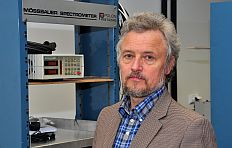
Head: prof. dr hab. Krzysztof Szymański
Room: 1053
Phone: 85-745 72 21
E-mail: k.szymanski@uwb.edu.pl
1. prof. dr hab. Krzysztof Szymański - head
2. dr hab. Andrzej Andrejczuk , prof. UwB
3. dr hab. Katarzyna Rećko , prof. UwB
4. dr hab. Dariusz Satuła , prof. UwB
5. dr Marek Brancewicz
6. dr Łukasz Łabieniec
7. dr Anna Matwiejczyk
8. dr Wojciech Olszewski
9. dr Krystyna Perzyńska
10. dr Piotr Zaleski
11. mgr inż. Maria Biernacka
12. mgr Marta Orzechowska
13. Bogusław Prus
Imaging of hyperfine interactions in Mössbauer spectrometry
Project title: Imaging of hyperfine interactions in Mössbauer spectrometry
Author and project manager: prof. dr hab. Krzysztof Szymański
Source of funding: National Science Centre
Research project type: OPUS 16
Agreement: UMO-2018/31/B/ST3/00279
Project implementation period: 36 months
Project value: PLN 1,217,630.00
Project goals:
Project implementation:
Synthesis of GaFeO3 single crystals and their studies by means of X-ray diffraction, Mössbauer spectroscopy, heat capacity, magnetic susceptibility and magnetization measurements.
National partners:
International partners: